 Technology peripherals
Technology peripherals
 AI
AI
 Beyond PaLM! Peking University Master proposed DiVeRSe, completely refreshing the NLP reasoning rankings
Beyond PaLM! Peking University Master proposed DiVeRSe, completely refreshing the NLP reasoning rankings
Beyond PaLM! Peking University Master proposed DiVeRSe, completely refreshing the NLP reasoning rankings
Large-scale language models can be said to be the cornerstone of modern natural language processing technology, such as GPT-3 with 175 billion parameters and PaLM with 540 billion parameters. Pre-training models provide very powerful few-shot learning for downstream tasks. ability.
But reasoning tasks are still a difficult problem, especially questions that require multi-step reasoning to get the correct answer.
Recently, researchers have discovered that as long as a properly designed prompt can guide the model to perform multi-step reasoning to generate the final answer, this method is also called chain-of-thought reasoning.
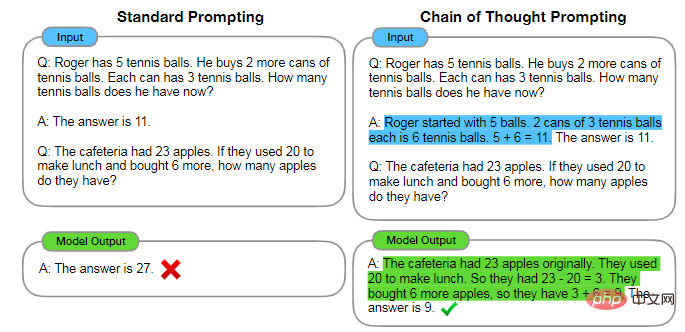
Thinking chain technology increased the accuracy from 17.9% to 58.1% on the arithmetic benchmark GSM8K. The self-consistency mechanism of voting introduced later further improved the accuracy. Increased to 74.4%
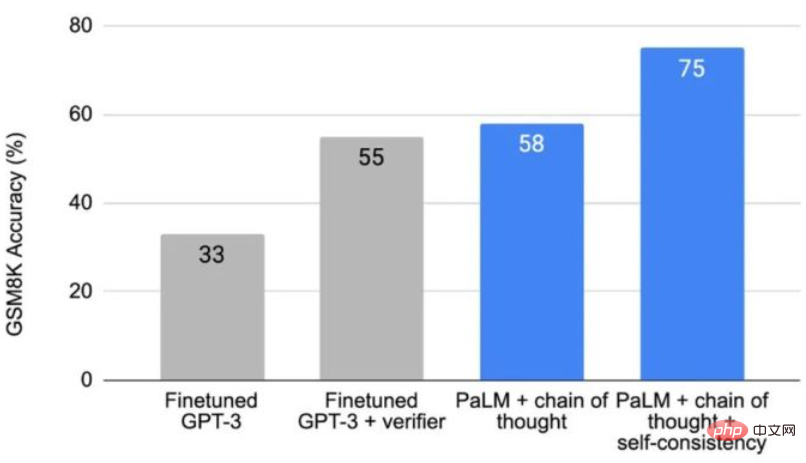
Simply put, complex reasoning tasks usually have multiple reasoning paths that can get the correct answer. The self-consistent method samples from the language model through the thinking chain A set of different reasoning paths, and then the most consistent answer among them is returned.
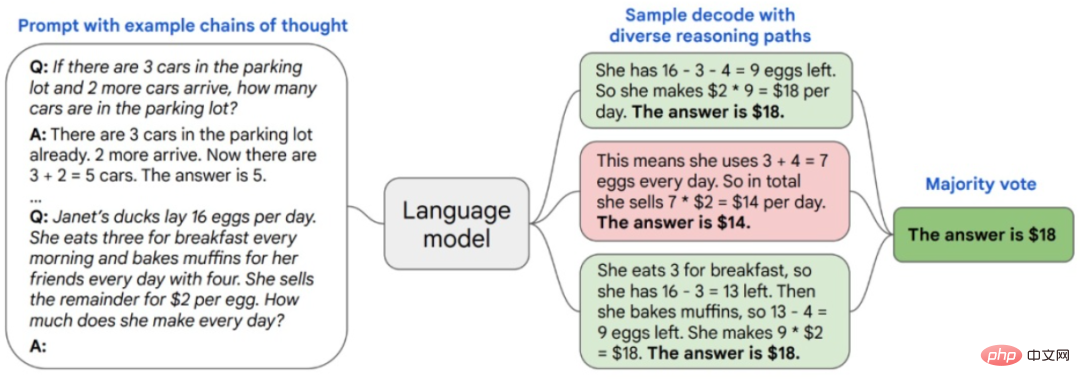
Recently, researchers from Peking University and Microsoft based on the new self-consistent method DiVeRSe, which contains three main innovation points, further improving the model's reasoning capabilities.

Paper link: https://arxiv.org/abs/2206.02336
Code link: https://github.com/microsoft/DiVerSe
First, inspired by the self-consistent approach of "different ideas, same answers", that is, sampling different reasoning paths from the language model, DiVeRSe goes a step further in diversity, following the principle of "all roads lead to Rome" The idea is that using multiple prompts to generate answers can generate more complete and complementary answers.
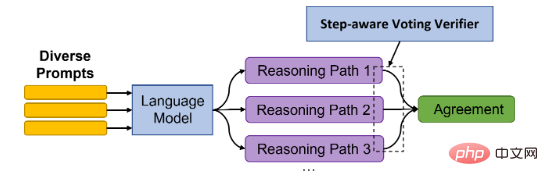
The researchers first provide 5 different prompts for each question, then sample 20 reasoning paths for each prompt, and finally Generate 100 solution reasoning paths for each question.
A key issue is how to obtain different prompts. Assume that after obtaining a sample library, we can sample K samples from it to construct a prompt, and then repeat it 5 times
If there are not enough samples, use self-teaching to improve prompt diversity, that is, generate pseudo inference paths and pairs from a part of the samples.

Second, when generating the inference path, there is no mechanism in the language model to correct errors in previous steps, which may lead to confusion in the final prediction result. DiVeRSe draws on the idea of verifier to verify the correctness of each reasoning path to guide the voting mechanism. That is, not all reasoning mechanisms are equally important or good.
Suppose we have 100 reasoning paths for a question, 60 of which result in "the answer is 110", and 40 of which result in "the answer is 150". Without a validator (i.e. the original self-consistent method), "the answer is 110" is a majority vote, so we can treat 110 as the final answer and delete the 40 reasoning paths that result in 150.
verifier scores the reasoning path. The function f is trained by a two-classifier. The input is question x, path z and answer y, and the output is the probability of positive.

With verifier, assume that the average score of the 60 reasoning paths of "The answer is 110" is 0.3; the average score of the 40 reasoning paths of "The answer is 150" is 0.8. Then the final answer should be 150, because 40*0.8>60*0.3
Thirdly, since the answer is generated based on multiple steps of reasoning, when a path generates a correct answer, it can be considered All steps contribute to the final correctness. However, when a wrong answer is generated, it does not mean that all steps were wrong or contributed to the error.
In other words, although the result is wrong, some intermediate steps may still be correct, but some subsequent deviation steps lead to the final wrong answer. DiVeRSe designed a mechanism to assign a fine-grained label to each step and proposed a step-aware verifier and assigned correctness to the reasoning of each step instead of just looking at the final answer.
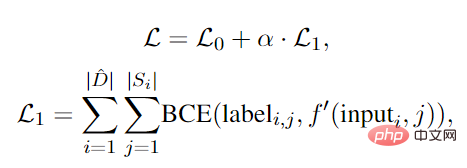
The main body is still a two-classifier, but the key question is how to obtain the step-level negative label, because if the final answer is wrong, without human participation, we I don’t know which step went wrong, but the correct answer is that the process should be correct.
Researchers proposed the concept of supports. For example, in arithmetic tasks, there needs to be an intermediate result of another example that is the same as the result of the intermediate step.
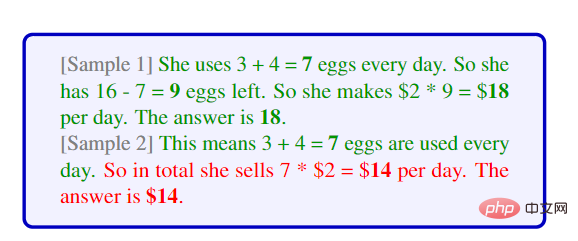
Based on these three improvements, the researchers conducted experiments on 5 arithmetic reasoning data sets. It can be seen that the DiVeRSe method based on code-davinci-002 has achieved The new SOTA algorithm has an average improvement rate of 6.2%. ), it is speculated that the reason may be that the common sense reasoning task is a multiple-choice task rather than an open-ended generation task, resulting in more false-positive pseudo-examples.
On the inductive reasoning task, DiVeRSe achieved a score of 95.9% on the CLUTRR task, exceeding the previous SOTA fine-tuning result (28.9%) 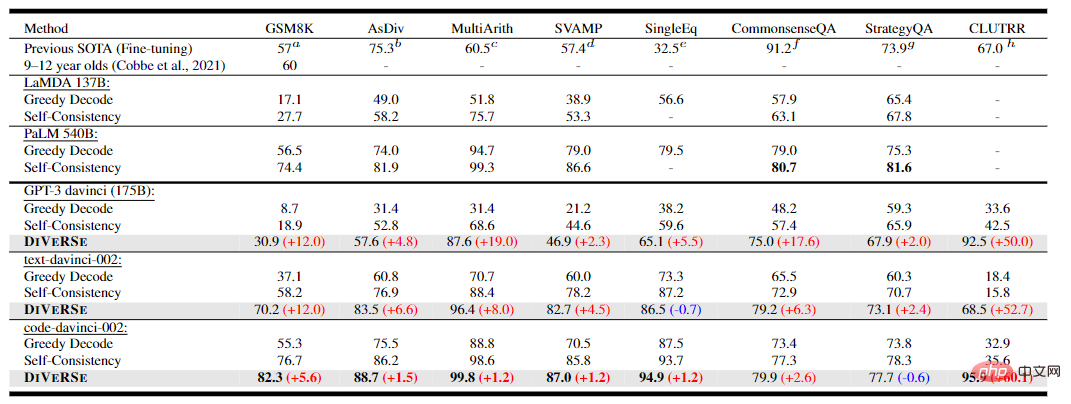
# In most experiments, extending the voting verifier to a step-aware version can improve performance. For code-davinci-002 on GSM8K, the step-aware version of verifier will cause a slight decrease in performance.
The possible reason is that code-davinci-002 is more powerful and can produce higher quality inference paths for GSM8K, thereby reducing the necessity of step-level information, i.e. text-davinci is more likely to generate short/incomplete inference path, while code-davinci is more friendly to generating growing content. 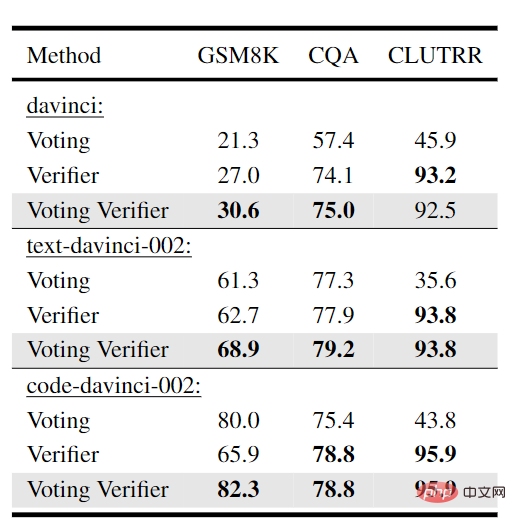
The first author of the paper is Yifei Li. He graduated from Northeastern University with a bachelor's degree in software engineering in 2020. He is currently studying for a master's degree at Peking University. His main research direction is natural language processing. , especially prompt-tuning and inference in large-scale language models.
The second author of the article is Zeqi Lin, a DKI researcher at Microsoft Research Asia. He received his bachelor's degree and doctorate degree from Peking University in 2014 and 2019 respectively. His main research direction is machine learning and its application in software analysis. and applications in data analysis. 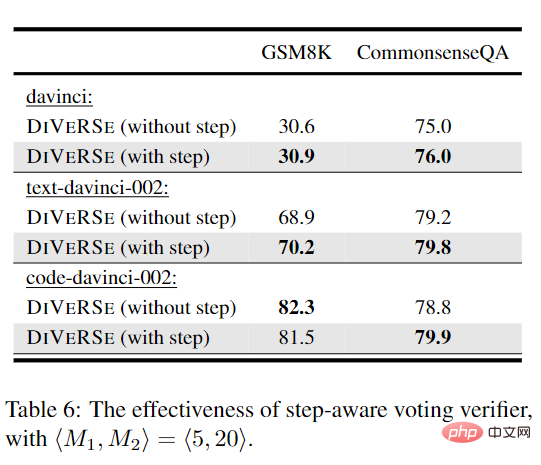
The above is the detailed content of Beyond PaLM! Peking University Master proposed DiVeRSe, completely refreshing the NLP reasoning rankings. For more information, please follow other related articles on the PHP Chinese website!

Hot AI Tools

Undresser.AI Undress
AI-powered app for creating realistic nude photos

AI Clothes Remover
Online AI tool for removing clothes from photos.

Undress AI Tool
Undress images for free

Clothoff.io
AI clothes remover

AI Hentai Generator
Generate AI Hentai for free.

Hot Article

Hot Tools

Notepad++7.3.1
Easy-to-use and free code editor

SublimeText3 Chinese version
Chinese version, very easy to use

Zend Studio 13.0.1
Powerful PHP integrated development environment

Dreamweaver CS6
Visual web development tools

SublimeText3 Mac version
God-level code editing software (SublimeText3)

Hot Topics
 1377
1377
 52
52
 Bytedance Cutting launches SVIP super membership: 499 yuan for continuous annual subscription, providing a variety of AI functions
Jun 28, 2024 am 03:51 AM
Bytedance Cutting launches SVIP super membership: 499 yuan for continuous annual subscription, providing a variety of AI functions
Jun 28, 2024 am 03:51 AM
This site reported on June 27 that Jianying is a video editing software developed by FaceMeng Technology, a subsidiary of ByteDance. It relies on the Douyin platform and basically produces short video content for users of the platform. It is compatible with iOS, Android, and Windows. , MacOS and other operating systems. Jianying officially announced the upgrade of its membership system and launched a new SVIP, which includes a variety of AI black technologies, such as intelligent translation, intelligent highlighting, intelligent packaging, digital human synthesis, etc. In terms of price, the monthly fee for clipping SVIP is 79 yuan, the annual fee is 599 yuan (note on this site: equivalent to 49.9 yuan per month), the continuous monthly subscription is 59 yuan per month, and the continuous annual subscription is 499 yuan per year (equivalent to 41.6 yuan per month) . In addition, the cut official also stated that in order to improve the user experience, those who have subscribed to the original VIP
 Context-augmented AI coding assistant using Rag and Sem-Rag
Jun 10, 2024 am 11:08 AM
Context-augmented AI coding assistant using Rag and Sem-Rag
Jun 10, 2024 am 11:08 AM
Improve developer productivity, efficiency, and accuracy by incorporating retrieval-enhanced generation and semantic memory into AI coding assistants. Translated from EnhancingAICodingAssistantswithContextUsingRAGandSEM-RAG, author JanakiramMSV. While basic AI programming assistants are naturally helpful, they often fail to provide the most relevant and correct code suggestions because they rely on a general understanding of the software language and the most common patterns of writing software. The code generated by these coding assistants is suitable for solving the problems they are responsible for solving, but often does not conform to the coding standards, conventions and styles of the individual teams. This often results in suggestions that need to be modified or refined in order for the code to be accepted into the application
 Can fine-tuning really allow LLM to learn new things: introducing new knowledge may make the model produce more hallucinations
Jun 11, 2024 pm 03:57 PM
Can fine-tuning really allow LLM to learn new things: introducing new knowledge may make the model produce more hallucinations
Jun 11, 2024 pm 03:57 PM
Large Language Models (LLMs) are trained on huge text databases, where they acquire large amounts of real-world knowledge. This knowledge is embedded into their parameters and can then be used when needed. The knowledge of these models is "reified" at the end of training. At the end of pre-training, the model actually stops learning. Align or fine-tune the model to learn how to leverage this knowledge and respond more naturally to user questions. But sometimes model knowledge is not enough, and although the model can access external content through RAG, it is considered beneficial to adapt the model to new domains through fine-tuning. This fine-tuning is performed using input from human annotators or other LLM creations, where the model encounters additional real-world knowledge and integrates it
 Seven Cool GenAI & LLM Technical Interview Questions
Jun 07, 2024 am 10:06 AM
Seven Cool GenAI & LLM Technical Interview Questions
Jun 07, 2024 am 10:06 AM
To learn more about AIGC, please visit: 51CTOAI.x Community https://www.51cto.com/aigc/Translator|Jingyan Reviewer|Chonglou is different from the traditional question bank that can be seen everywhere on the Internet. These questions It requires thinking outside the box. Large Language Models (LLMs) are increasingly important in the fields of data science, generative artificial intelligence (GenAI), and artificial intelligence. These complex algorithms enhance human skills and drive efficiency and innovation in many industries, becoming the key for companies to remain competitive. LLM has a wide range of applications. It can be used in fields such as natural language processing, text generation, speech recognition and recommendation systems. By learning from large amounts of data, LLM is able to generate text
 To provide a new scientific and complex question answering benchmark and evaluation system for large models, UNSW, Argonne, University of Chicago and other institutions jointly launched the SciQAG framework
Jul 25, 2024 am 06:42 AM
To provide a new scientific and complex question answering benchmark and evaluation system for large models, UNSW, Argonne, University of Chicago and other institutions jointly launched the SciQAG framework
Jul 25, 2024 am 06:42 AM
Editor |ScienceAI Question Answering (QA) data set plays a vital role in promoting natural language processing (NLP) research. High-quality QA data sets can not only be used to fine-tune models, but also effectively evaluate the capabilities of large language models (LLM), especially the ability to understand and reason about scientific knowledge. Although there are currently many scientific QA data sets covering medicine, chemistry, biology and other fields, these data sets still have some shortcomings. First, the data form is relatively simple, most of which are multiple-choice questions. They are easy to evaluate, but limit the model's answer selection range and cannot fully test the model's ability to answer scientific questions. In contrast, open-ended Q&A
 Improved detection algorithm: for target detection in high-resolution optical remote sensing images
Jun 06, 2024 pm 12:33 PM
Improved detection algorithm: for target detection in high-resolution optical remote sensing images
Jun 06, 2024 pm 12:33 PM
01 Outlook Summary Currently, it is difficult to achieve an appropriate balance between detection efficiency and detection results. We have developed an enhanced YOLOv5 algorithm for target detection in high-resolution optical remote sensing images, using multi-layer feature pyramids, multi-detection head strategies and hybrid attention modules to improve the effect of the target detection network in optical remote sensing images. According to the SIMD data set, the mAP of the new algorithm is 2.2% better than YOLOv5 and 8.48% better than YOLOX, achieving a better balance between detection results and speed. 02 Background & Motivation With the rapid development of remote sensing technology, high-resolution optical remote sensing images have been used to describe many objects on the earth’s surface, including aircraft, cars, buildings, etc. Object detection in the interpretation of remote sensing images
 Five schools of machine learning you don't know about
Jun 05, 2024 pm 08:51 PM
Five schools of machine learning you don't know about
Jun 05, 2024 pm 08:51 PM
Machine learning is an important branch of artificial intelligence that gives computers the ability to learn from data and improve their capabilities without being explicitly programmed. Machine learning has a wide range of applications in various fields, from image recognition and natural language processing to recommendation systems and fraud detection, and it is changing the way we live. There are many different methods and theories in the field of machine learning, among which the five most influential methods are called the "Five Schools of Machine Learning". The five major schools are the symbolic school, the connectionist school, the evolutionary school, the Bayesian school and the analogy school. 1. Symbolism, also known as symbolism, emphasizes the use of symbols for logical reasoning and expression of knowledge. This school of thought believes that learning is a process of reverse deduction, through existing
 SOTA performance, Xiamen multi-modal protein-ligand affinity prediction AI method, combines molecular surface information for the first time
Jul 17, 2024 pm 06:37 PM
SOTA performance, Xiamen multi-modal protein-ligand affinity prediction AI method, combines molecular surface information for the first time
Jul 17, 2024 pm 06:37 PM
Editor | KX In the field of drug research and development, accurately and effectively predicting the binding affinity of proteins and ligands is crucial for drug screening and optimization. However, current studies do not take into account the important role of molecular surface information in protein-ligand interactions. Based on this, researchers from Xiamen University proposed a novel multi-modal feature extraction (MFE) framework, which for the first time combines information on protein surface, 3D structure and sequence, and uses a cross-attention mechanism to compare different modalities. feature alignment. Experimental results demonstrate that this method achieves state-of-the-art performance in predicting protein-ligand binding affinities. Furthermore, ablation studies demonstrate the effectiveness and necessity of protein surface information and multimodal feature alignment within this framework. Related research begins with "S



